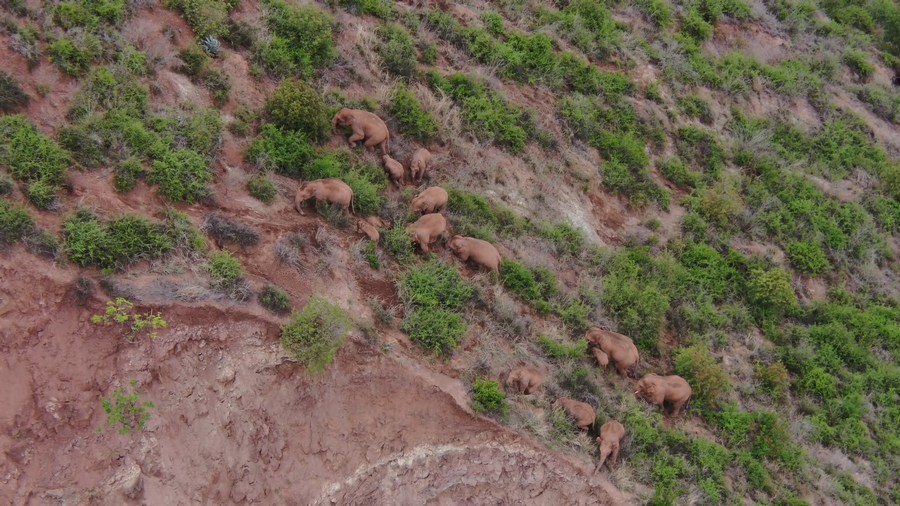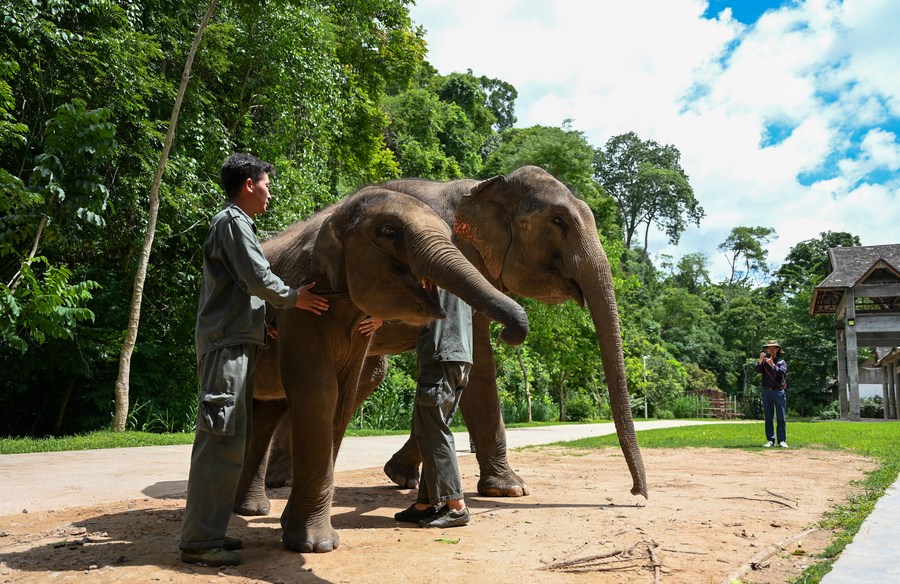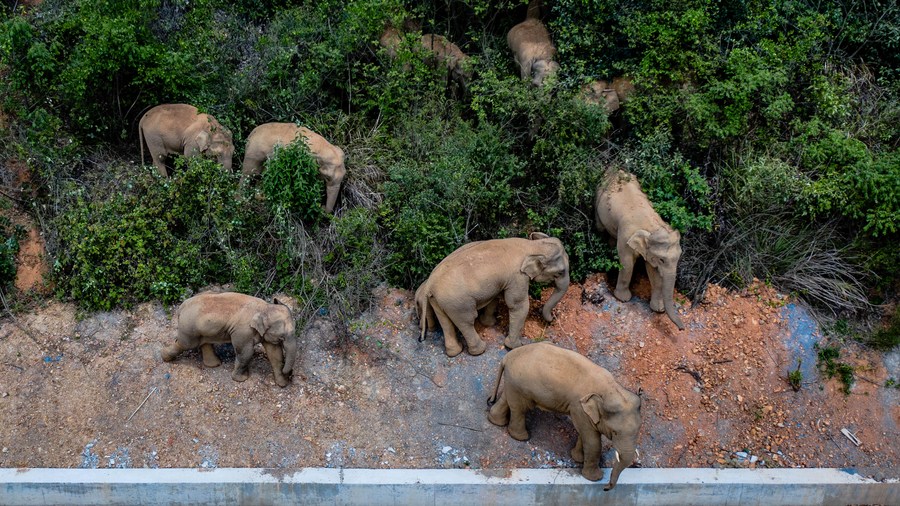Zooming into the life, habitat of China's wandering elephants
-- Fifteen wild Asian elephants have wandered far and wide trekking about 500 km to the outskirts of Kunming, capital of southwest China's Yunnan Province, probably one of the longest journeys ever recorded for such a herd in China.
-- Over the years, the wild giant mammals frequently leave their protected areas and intrude the nearby villages, which is viewed by some experts as a result of the degradation of their original habitats as well as changes in dietary habits of the species.
-- Experts have noted that the environment is more unsuitable for the Asian elephants to survive as they migrate farther north.
KUNMING, June 19 (Xinhua) -- A herd of 15 wild Asian elephants that have captured global attention continue to enjoy their trek in southwest China unperturbed.
It has been 15 months since the herd bid farewell to their original habitat in a nature reserve in Xishuangbanna Dai Autonomous Prefecture, Yunnan Province.
To date, the elephants have wandered far and wide trekking about 500 km to the outskirts of the provincial capital Kunming -- probably one of the longest journeys ever recorded for a herd of elephants in the country.
Everyone keeps a close tab on them, including their guardians back home. The reason they left their leafy habitat, where lush forests seem to touch the sky, remains an enigma.

The aerial video screenshot taken on June 18, 2021 shows a herd of wild Asian elephants in Eshan County of Yuxi City, southwest China's Yunnan Province. (Xinhua)
UNDER HUMAN ESCORT
The Wild Elephant Valley, tucked away in the Xishuangbanna national nature reserve, serves as a natural conduit for wildlife, a place frequented by Asian elephants.
In a bid to evaluate the reproduction and living conditions of the elephants, the reserve set up an Asian elephant observation and protection team in 2005.
The team currently has nine members, growing from four initially, with the average age being around 32.
Team leader Ai Hanlu is one of the familiar faces for the migrating elephants, as his team tracks them almost on a daily basis. On May 30, the 46-year-old Ai was sent to the city of Yuxi, Yunnan, where the migrating elephants had been resting as of Saturday.
By observing the footprints of the elephants, Ai can roughly estimate where the herd is heading and alert the nearby villagers and tourists.

Guardians play with the rescued Asian elephants at the Asian Elephant Breeding and Rescue Center in Xishuangbanna Dai Autonomous Prefecture, southwest China's Yunnan Province, June 17, 2021. (Xinhua/Wang Guansen)
To better preserve the species and avoid possible human-elephant conflicts, Xishuangbanna set up an Asian elephant monitoring and warning center in Menghai County in 2018.
Once the elephants are spotted, Pu Zongxin, 50, will send warning messages to online platforms through his phone, alerting residents in the vicinity to be careful.
Earlier, Pu had to closely follow the elephants so that he can trace the species. Thanks to the use of drones, now he no longer has to spend plodding hours tracking the animals.
"I can roughly tell the places where the elephants have been and the food they ate from their excrement," Pu said.
Pu said that he has noticed changes in the dietary habits of the elephants over the years. The behemoth mammals used to feed on sugar canes and corn, but pineapples and dragon fruits planted by local farmers have now become their favorite.

Aerial photo taken on May 28, 2021 shows a herd of wild Asian elephants in Eshan County, Yuxi City, southwest China's Yunnan Province. (Xinhua/Hu Chao)
FOSTERING ELEPHANT HABITATS
Asian elephants, the continent's largest land animal, are under top-level protection in China.
In 1958, the country set up one of its earliest national nature reserves in Xishuangbanna to protect the rare animals. Since then, governments at all levels have gone all out to rescue and preserve the species.
Currently, Yunnan has 11 national or regional nature reserves in the tropics where the elephants haunt, covering a total area of about 510,000 hectares.
Thanks to relentless protection efforts, the wild elephant population in Yunnan has grown from 193 in the 1980s to about 300, with the Xishuangbanna nature reserve boasting the largest number of them.
"In recent years, the area of natural forests in the reserve has been on the rise, with the forest coverage rate exceeding 95.7 percent. The population of its major protected species including the Asian elephants has remained stable and burgeoning," said Yang Yun, head of the nature reserve's administration and protection bureau.
With increasing forest coverage at the Xishuangbanna nature reserve, shrubs and grasslands that the elephants prefer are gradually scaling back. Giant arbors densify the forests, making it harder for the elephants to find sufficient herbaceous plant resources, according to Guo Xianming, director of the scientific research institute under the reserve.
"A high forest coverage rate is a good thing for birds and rodents that feed on fruits, but not so ideal for the Asian elephants as they prefer places with more sunlight," Guo added.
Outside the reserve, elephants find crops such as sugar cane and corn grown by local villagers alluring due to their higher nutritional value.
In recent years, the wild Asian elephants frequently leave their protected areas and intrude the nearby villages, which is viewed by some experts as a result of the degradation of their original habitats as well as changes in dietary habits of the species.
"The monitoring results show that in the past the Asian elephants had to spend more than 10 hours to get food for one single day. Now they can find what they need in a few hours easily," Guo said, explaining why the elephants have started to change their diet.

Aerial photo taken on June 15, 2021 shows a view of the Asian elephant observation station and nearby food supply base outside Liushun Township of Pu'er City, southwest China's Yunnan Province. (Xinhua/Wang Guansen)
Over the years, Xishuangbanna has been actively restoring the habitats and areas with food sources for the elephants. To meet the demands of the increasing elephant population, the prefecture plans to increase the area of suitable habitats for the Asian elephants and better connect the currently fragmented habitats by means of turning marginal farmland into forest.
Meanwhile, Yunnan is expected to build a rainforest national park and to better coordinate trans-regional ecological protection and relevant facility construction.
In Xishuangbanna's neighboring city of Pu'er, over 180 wild elephants have been monitored since 1992. The city has designated areas totaling 260 hectares to grow food for elephants. During seasons with food shortage risks, authorities would prepare some food in fixed places, dubbed "elephant canteens," in order to avoid elephants from entering human settlements.
Though there seems slim hope that the migrating elephant herd will return to their original habitat in Xishuangbanna of their own accord in the foreseeable future, experts have noted that the environment is more unsuitable for the Asian elephants to survive as they migrate farther north.
It is hoped that with the help and efforts of humans, the elephants will soon return to their suitable habitats in the south, said Chen Fei, director of the Asian elephant research center under the National Forestry and Grassland Administration.
Photos
Related Stories
- Primary school ensures it's now elephant-proof
- China's migrating elephant herd shows returning trend
- Two elephant calves play-fight in Yunnan
- Yunnan animal center works to save Asian elephants, expand their population
- China's migrating elephant herd lingers in southwest township
- China's migrating elephants linger by township in Yunnan
- China's migrating elephant herd heads further southwest
- Elephant herd continues to wander in major Chinese city
- 2 dead in China elephant attacks
- ‘Border residents’ roam freely between China and Laos
Copyright © 2021 People's Daily Online. All Rights Reserved.










